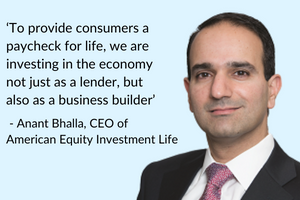
American Equity Investment Life Holding Company, a top-ten seller of fixed indexed annuities (FIA), continues to execute its “AEL 2.0” strategy—a blueprint for survival in today’s low interest environment. Other small to mid-sized publicly traded annuity issuers will no doubt take notice.
The company has described AEL 2.0 as a roadmap that will turn AEL from a “spread-based business” into a less capital-intensive, more profitable “fee-based business” that it hopes will elicit more “buy” recommendations from Wall Street analysts. AEL 2.0 also includes a tilt in investment allocations toward private credit and equity.
The company’s makeover since the hiring of Anant Bhalla as CEO in early 2020 includes the adoption a new slogan—AEL wants to be known as a provider of “financial dignity” to retired Americans—and a plan to eventually to deploy “30% to 40%” of its general account to private assets, up from about 15% today.
AEL’s third-quarter 2021 annuity sales (by American Equity Life and Eagle Life) were $1.31 billion, up 128% from the third quarter 2020 sales level and 11% from the second quarter of 2021. In the first half of 2021, the company sold $2.03 billion worth of fixed-rate deferred annuities and $1.55 billion of FIAs, according to LIMRA.
AEL seems especially interested in the booming residential home rental market. “Single-family homes built to rent are emerging as the hottest corner of the US property market, as investors respond to booming demand from home-seekers priced out of housing for sale,” the Wall Street Journal reported this week.
“The expected risk-adjusted annual return for built-to-rent investments in the private market is now about 8% on average… the highest of 18 property sectors tracked by the firm,” the article said.
“Yes, I think there is a good ten-year (plus) run ahead of us in built-for-rent. I do think this segment has long-term potential,” Brad Hunter, president of Hunter Housing Economics told RIJ yesterday. “Investors in built-for-rent will see outsized risk-adjusted returns for at least the next six years, the way I see it. After that point, there will be more supply, so the gains won’t be quite so extreme. But the business will still be quite sound.”
Brave new world
If successful, AEL 2.0 may represent a new kind of business model for a more nimble, profitable and sustainable life insurer that can thrive even in low interest rate environments. That contrasts with the traditional life/annuity business model for much of the 20th century, which focused on buying safe corporate bonds and holding them to maturity, and to some extent offsetting the longevity risk of their annuities with the mortality risk of their life insurance products.
Squeezed between liabilities to policyholders and stingy yields on the traditional bonds in their general accounts, publicly traded life insurers have over the past decade responded by issuing more conservative products, reinsuring old blocks of business, and taking more risk with their investments.
On the retail product side, these insurers have focused on selling more indexed annuities, a type of structured product that exposes life insurers to much less market risk than traditional deferred variable annuities with lifetime income riders. The riskier general account investments include private credit and private equity. These are customized debt and securities not available in public financial markets.
Recent AEL private asset deals
Several pieces of the AEL 2.0 were announced this year. As RIJ reported, the company closed a $10 billion reinsurance and investment deal with Brookfield Re. This week, AEL invested $1 billion in “a technology lending platform,” created by Monroe Capital, that will originate customized, high-yield loans to middle market software and technology companies.
The majority of investment commitments made in the third quarter represent the continued expansion of American Equity’s allocation to residential and commercial real estate assets while the capital deployed in private assets was across middle market corporate loans, agriculture loans and real estate debt, an AEL release said.
Last week, AEL announced that it had provided financing and capital to help Pretium—a specialized asset manager with about $30 billion in assets—acquire Anchor Loans, a provider of financing to residential real estate investors and entrepreneurs.
“In supporting Pretium’s acquisition of Anchor Loans, we are also able to enhance our allocation to high quality residential real estate assets—a key pillar of our AEL 2.0 investment strategy,” said Pradip Ghosh, AEL’s head of Return on Assets.
In late September, AEL announced that it had hired BlackRock and Conning to manage its bond portfolio, starting in 2022. Its in-house investment managers “will focus on private assets, cash and derivative trading, unique asset allocation for insured client solutions and asset liability management.”
“Over the next few years, we intend to further scale up [our] allocation to private assets, total assets earning fees or investment spread, and third party capital through reinsurance… improving shareholder returns by migration to the capital-light model we envisioned,” American Equity’s President and CEO, Anant Bhalla, said in a release. “AEL is re-imagining its target markets to be The Financial Dignity Company that delights customers as they realize financial dignity from our solutions well beyond their prime earnings years.”
Jim Hamalainen, Chief Investment Officer, said: “Year-to-date as of today, we have deployed approximately $2.5 billion in private assets. This exceeds our plans for 2021 and was supported by our acquisition of a residential loan portfolio from the Anchor Loan platform to help support its acquisition by our residential real estate partner, Pretium.” American Equity is pursuing “differentiated asset management with a lower risk profile than other asset intensive insurance business models,” he noted.
© 2021 RIJ Publishing LLC. All rights reserved.

